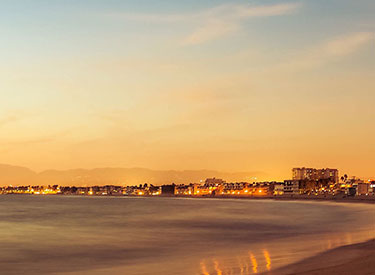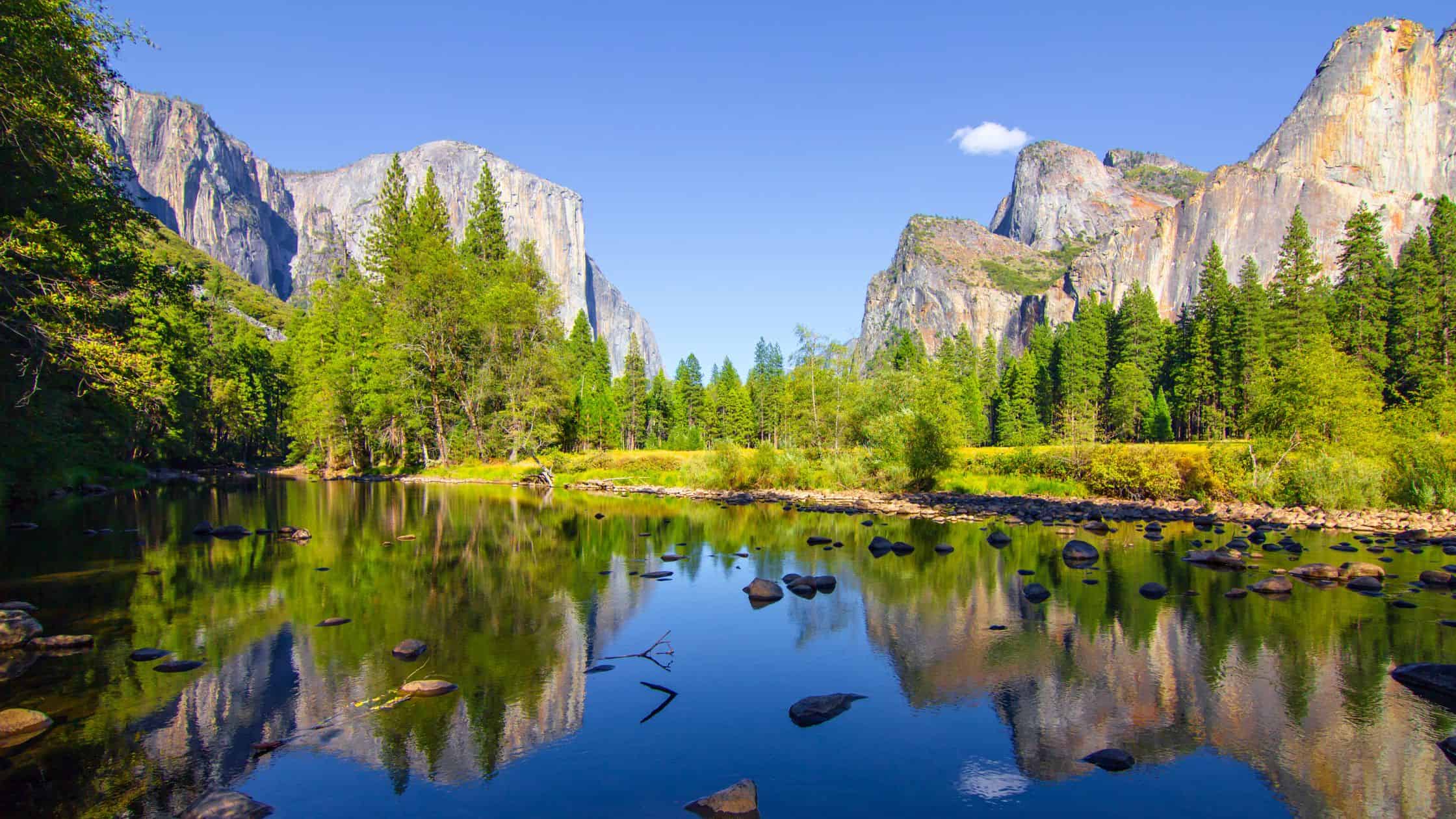


There are 63 National Parks within the borders of the United States, the oldest of which is Yellowstone National Park (Wyoming, created in 1872). Created to conserve areas of outstanding natural and historical significance, the parks contain a variety of unique landscapes and wildlife. They provide a spectacular setting for every imaginable recreational activity, including ice climbing and whitewater rafting, birdwatching and fishing, snorkelling and of course, hiking.
From Acadia (Maine) to Zion (Utah), these are seven of our favourite scenic National Parks hikes in the US, ranging from short, easy trails to challenging, full-day adventures.
More than 4.5 million visitors visit the park each year to explore its slot canyons, rugged mountains and rock arches. One of the park’s most popular features is Zion Canyon, where you’ll find a variety of trails to suit all levels of fitness and mobility.
Angel’s Landing is one of the canyon’s most photogenic trails, but also one of its most challenging, and you should only attempt it if you have a good head for heights. It starts out easily enough, following a well-formed path for the first few kilometres before making a short, sharp ascent via twenty-one thigh-burning switchbacks to reach Scout Lookout. Anchored support chains line the final, heart-stopping climb along a narrow ridge to the summit, where you’ll be rewarded with spectacular views to the canyon floor, far below.
Length: 8.7-kilometre round trip
Duration: 4 hours
Elevation change: 453 metres
Level: challenging
Pro tip: due to its immense popularity, you must arrange a permit if you want to tackle this spectacular trail. You can apply online for your preferred dates ahead of your visit – the booking lottery for each block of hiking dates opens two months prior. There’s also a daily lottery that distributes a limited number of permits for the following day, with bookings opening at midnight the day prior.
Easier option: it takes around 1.5 hours (return) to hike to the Emerald Pools via the Kayenta Trail, taking in the beauty of Zion Canyon along the way.
There are more than 2,000 red sandstone arches within just 300 square kilometres of national park, the most iconic of which is Delicate Arch. Standing sixteen metres high, this freestanding formation is said to resemble a set of cowboy chaps or a pair of old-fashioned bloomers. There are two viewpoints where you can admire the Arch from afar, but we recommend taking the longer, more challenging hike to the arch itself.
The experience is spectacular at any time of day, but the views are even more memorable at sunrise and sunset when the red rocks are bathed in a golden glow.
Length: 4.8 kilometres (round trip)
Duration: 2-3 hours
Elevation change: 164 metres
Level: strenuous
Pro tip: summer temperatures in the park can reach over 37°C, and there are no trees along the trail to provide shade. During the winter months, ice can make the wind-smoothed terrain treacherously slippery. The best times of year are either April-May and September-October, but be sure to pre-book your timed entry to the park if you’re planning to visit the park between 7am and 4pm.
Easier option: there are several short, easy walks within the Windows section of Arches National Park, including the Windows Loop and the Double Arch trail.
From the top of Half Dome, the sweeping views of Yosemite Valley will take away any remaining breath you possess after having completed the famously difficult ascent. This hike is not for the faint-hearted and should not even be attempted unless you have a good level of fitness.
From the valley floor, you’ll scale carved stone steps and navigate endless switchbacks before reaching the final, most difficult, climb to the summit. Permits are a must if you want to tackle Half Dome between May and October. The main climbing season runs from May to October, and you must have a permit to hike Half Dome during this period. The permit lottery opens in March each year, or you can take your chances on scoring one of the additional permits that are made available two days in advance.
Length: 22-26 kilometres (round trip)
Duration: 10-12 hours
Elevation change: 1475 metres
Level: strenuous
Pro tip: Every year, the Parks Service reinstalls a pair of cables that hikers use as handholds to climb the smooth, curved face of the dome. Although these cables remove the need for specialised climbing equipment, it’s a good idea to use sturdy gloves for this section if you want to minimise the risk of painful blisters forming on your hands. The descent is even more challenging than the ascent, so be sure to allow plenty of time for the return leg of your adventure.
Easier option: the trail to Glacier Point is less than a kilometre long but it will still leave you breathless, thanks to the epic views that take in Half Dome and the Upper and Lower Yosemite Falls.
With its landscape of alpine meadows and snow-fed lakes, towering peaks and incredible wildlife, not to mention more than 500 kilometres of spectacular trails, Rocky Mountain National Park is a hiker’s dream. The hike to Sky Pond is a fantastic way to take in a slice of the park’s most stunning scenery, including Alberta Falls, Loch Vale and the Lake of Glass.
Unless you’re a highly experienced mountaineer, it’s best to plan your visit between late June and early October, when the weather is typically mild and settled (note: timed entry permits are required during this period).
Length: 13.8 kilometres (round trip)
Duration: 4-6 hours
Elevation change: 541 metres
Level: strenuous
Pro tip: even the lowest-lying parts of Rocky Mountain National Park are around the same altitude as the summit of Australia’s highest peak, Mt Kosciuszko, and even the fittest hikers can experience altitude-related problems like headaches, shortness of breath and elevated heartrate. You can minimise the effects of high altitude by keeping well-hydrated, avoiding alcohol, and getting plenty of rest.
Easier option: you don’t have to complete the entire trail to enjoy spectacular views of the Glacier Gorge. It’s a short, sharp climb of around twenty minutes to reach the dramatic Alberta Falls, although you’re likely to hear the roaring water before they’re even in sight.
If you’ve always dreamed of frolicking through summer wildflower meadows, surrounded by rugged peaks and ancient glaciers, this is the hike for you. During the summer months, people come from all over the world to this area of the park, aptly known as Paradise, to marvel at its stunning seasonal display of alpine flowers.
From the trailhead, you’ll climb through subalpine forest, mountain lilies and bright patches of heather before emerging above the treeline to sweeping views of the surrounding mountains.
Length: 6.26 kilometres (round trip or loop)
Duration: 2.5 hours
Elevation change: 404 metres
Level: moderate
Pro tip: the higher sections of the trail can be covered in patches of snow, even during the summer months, so always check trail conditions at the visitor centre before you start your walk.
Easier option: follow the Skyline trail for around 25 minutes and you’ll reach Myrtle Falls: a 60-metre cascade with Mt Rainier as its backdrop.
Although the trailhead is located just 120 kilometres from Washington DC, you’ll feel a million miles from civilisation as you hike through the lush forest of the renowned hiking paradise of the Blue Ridge Mountains.
One of our favourite highlights of this trail is the rock scramble: it’s a fun challenge to navigate over, across and between the jumble of massive granite boulders. From the summit, the views are endless and spectacular, especially in the autumn when the valleys are ablaze with shades of gold, orange and red.
Length: 15.4 kilometres (loop)
Duration: 5-6 hours
Elevation change: 794 metres
Level: challenging
Pro tip: this is one of the park’s most popular day hikes, so it’s wise to set off early if you want to enjoy the best possible wilderness experience. A park pass is required year-round, along with a timed entry permit for the trail if you’re visiting between March and November.
Easier option: the Hawksbill Summit trail is shorter and doesn’t involve any rock scrambling, but you’ll still be rewarded with epic views from the highest peak in Shenandoah.
There are more than 200 kilometres of hiking trails and 70 kilometres of car-free carriage trails to explore within the park, criss-crossing mountains and skirting the scenic bays, coves and cliffs of the Maine coastline. Cadillac Mountain is the highest point in Acadia, and between October and March, its summit is the first place in the United States to see the sun.
Most of the trail is a steady climb through spruce and pine forest, gradually revealing stunning views of the Atlantic Ocean and the offshore Porcupine Islands. Keep an eye out for the Zen-like piles of stone that line the trail at regular intervals. Weather conditions can change quickly, and these stone cairns function as picturesque route markers to help you stay on track.
Length: 10.8 kilometres (round trip)
Duration: 2-4 hours
Elevation gain: 472 metres
Level: moderate
Pro tip: follow the short side trail to Eagles Crag lookout: the outcrop of pink granite is the perfect spot to catch your breath while soaking up incredible views of the surrounding landscape.
Easier option: If you’re not prepared to tackle the hike, you can drive right to the summit car park and watch the sunrise over the Atlantic Ocean from the comfort of your car (vehicle reservations are required between May and October).
From thundering waterfalls and snow-fed glaciers to vast desert landscapes and sweeping coastal scenery, the United States’ National Parks contains some of the world’s most scenic hiking trails. To add a taste of the great outdoors to your USA holiday plans, talk to your personal travel manager.